"Industrial Agents" Rise: How Edge Computing and AI Agents Are Reconstructing the Future of Industry?
![]() 04/30 2025
04/30 2025
![]() 804
804
IoT Intelligence Original
Despite the digital transformation wave sweeping through the industrial sector for over a decade, most factory systems remain at the "automated but not intelligent" stage. Sensors, PLCs, MES, cloud platforms, and other components are in place, yet systems are fragmented. Data is collected but difficult to understand, algorithms run but fail to adapt to changes, and the realization of a closed-loop intelligence of "perception-cognition-decision making" remains elusive. Why does AI struggle to gain traction in industrial scenarios? Why do increasingly powerful AI models fail to gain practical applications? Where is the breakthrough for industrial intelligence? We may be standing at a new historical turning point, where the combination of AI Agents and Edge Computing emerges as a new path to solve these challenges. This is not just a technological combination but a reconstruction of the industrial development model:
Edge computing brings computing power to the field, enabling millisecond-level data processing and real-time feedback.
AI Agents endow edge nodes with autonomous capabilities of "perception-cognition-decision making".
Together, they drive industrial systems from "passive response" to "active evolution" and from "centralized automation" to "distributed agent networks".
Against this backdrop, IoT Intelligence had the privilege of engaging in an in-depth dialogue with Liu Kezhen, Chairman of Advantech, and Kang Ning, R&D Director of WISE-PaaS/AI Agents, on the "era of industrial agents". This article will draw on this exchange to explore, from the triple dimensions of technology, strategy, and ecosystem, how edge computing and AI Agents are constructing a new foundation for industrial intelligence and predict the future of the industry driven by the dual engines of "vertical models + edge intelligence".
The Emergence of AI Agents: A New Engine for "Perception-Cognition-Execution" in Industrial Intelligence
If edge computing is an infrastructure upgrade for industrial intelligence, the introduction of AI Agents signifies a shift from "process-driven" to "intelligence-driven" models in industrial systems.
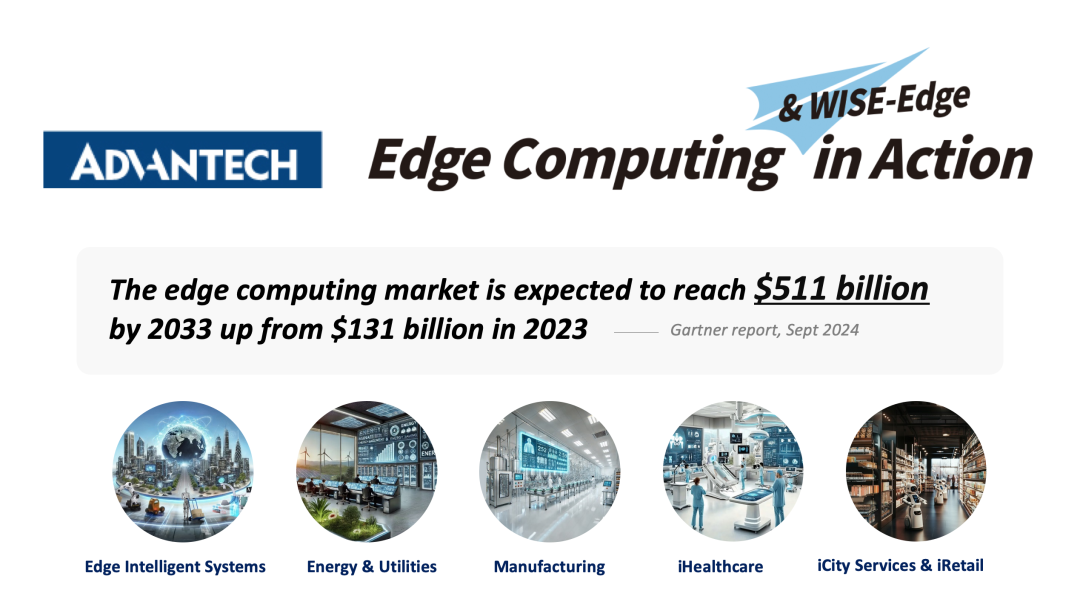
Undoubtedly, more and more enterprise applications are beginning to run at the edge. According to Gartner's prediction, by 2027, 50% of critical enterprise applications will run at the edge. Enterprises are continuously investing in edge computing, and global edge computing spending is expected to grow steadily with a double-digit compound annual growth rate (CAGR) from 2024 to 2033. Coupled with the continuous evolution of AI, edge intelligence is also showing strong development momentum.
Gartner further predicts that by 2026, 50% of global edge deployments will include AI. Liu Kezhen, Chairman of Advantech, keenly observed that the evolution from automation to intelligence in industrial scenarios has now reached a significant turning point. Although AI has not been widespread for long, its trend is very strong. With the increasingly perfect integration of AI Agents and AI models in niche areas, comprehensive AI Agents in industrial scenarios are beginning to lead the transformation towards intelligence.
In the past, without cloud-edge collaboration solutions, the industrial control ecosystem of each factory was customized by automation teams according to in-scene requirements, forming a closed system. Such systems rely on preset rules and static logic, making it difficult to cope with complex and dynamic production environments. With the popularization of cloud-edge collaborative computing, the originally closed industrial systems have been initially liberated.
In the era of AI Agents, production materials within the scene will be further integrated into specific small models (SLMs), combined with comprehensive industry knowledge in the cloud and at the edge to realize intelligent communication and sharing. Liu Kezhen, Chairman of Advantech, stated that "Industrial Agents connect everything within the scene, and the efficiency and degree of intelligence of the entire industry will experience explosive growth." Intelligent entities with environmental perception, autonomous decision-making, and execution capabilities achieve a leap from "passive execution" to "active evolution" through the closed loop of "perception-decision-execution". This ability makes AI Agents the ultimate carrier of industrial AI: they can be embedded in physical devices to realize "edge intelligence" and form "collective wisdom" through cloud training and iteration, pushing industrial systems from "customized but closed local optimization" to "open and customized global intelligence".
Core Capability Structures of Industrial AI Agents
The so-called AI Agents are not a single functional module but intelligent entities with the abilities to perceive the environment, understand tasks, make autonomous decisions, and collaborate on execution. They are embedded in device ends or edge nodes and can independently complete closed-loop tasks from data collection, analysis, judgment to action without relying on the cloud, becoming the true "executors" and "thinkers" of edge intelligence. The three core capability structures of industrial AI Agents include:
1. Perception Capability
- Multi-modal sensor fusion (vision, sound, vibration, temperature, humidity, etc.)
- Real-time data collection and preprocessing at the edge
- State recognition and environmental understanding
2. Cognitive Capability
- Task understanding and reasoning analysis supported by embedded AI small models
- Intelligent decision-making mechanism in collaboration with industry knowledge graphs
- Self-learning and model optimization
3. Decision-Making and Execution Capability
- Issuance of control commands in linkage with on-site equipment
- Coordinated scheduling among multiple agents
- Feedback and self-correction after task completion
This capability structure makes AI Agents no longer passive algorithmic tools but intelligent working nodes with "situational understanding + collaborative execution", driving industrial systems to evolve from "command-based execution" to "goal-oriented collaboration". It should be noted that the rise of AI Agents is not to subvert the traditional automation upgrade path but to reconstruct the underlying logic of industrial intelligence through more comprehensive data, finer models, and more powerful edge computing, using the autonomous cognition of agents to drive the enhancement of scenario intelligence capabilities.
The introduction of industrial AI Agents is not a replacement for traditional automation but a leap in system architecture and intelligent logic. Kang Ning, R&D Director of Advantech, also mentioned that this leap in industrial intelligence requires agents to build an intelligent hub for the integration of IoT and models in industrial scenarios, completing the closed loop of data from perception, aggregation to autonomous decision-making, and even end-to-end execution, ultimately helping enterprises build their exclusive "think tank".
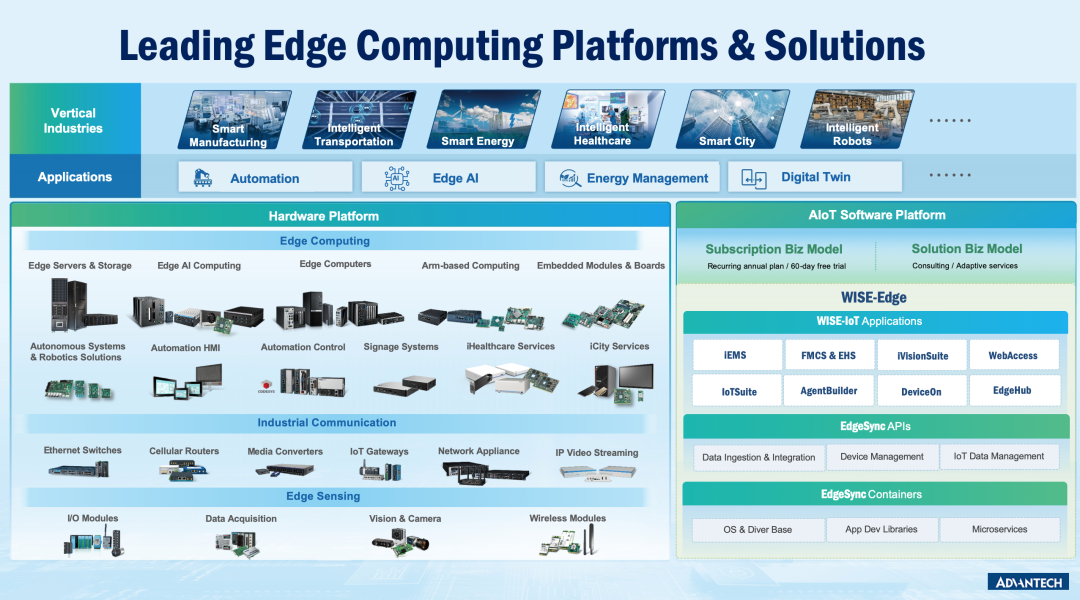
Strategic Transformation and Ecosystem Collaboration
It is foreseeable that the entire industry will have many demands for edge intelligence transformation. It is against this backdrop that Advantech began its strategic transformation from "a leading industrial computer enterprise" to "an Edge AI leader", that is, from providing industry hardware platforms and software tools to developing AI Agents on Edge, where edge computing hardware and intelligent software are fully integrated. This deep integration of AI hardware and software collaboratively solves many technical bottlenecks in the implementation of industrial AI, jointly promoting the comprehensive intelligence of industrial applications based on the deep coupling of OT and IT.
From underlying technology to ecosystem collaboration, constructing the core capabilities of industrial AI Agents. Whether it is industrial AI or specifically industrial agents, its core technology system revolves around data-driven decision-making, real-time response, and autonomous collaboration, which can be decomposed into the following core modules:
- Local real-time data processing enabled by edge computing hardware: Edge computing hardware achieves millisecond-level response by bringing computing power to device ends or near-field nodes, meeting the stringent requirements of industrial scenarios for low latency.
- Refined AI models based on industrial scenarios: Customized scenario AI models optimized through techniques such as model pruning and quantization to adapt to resource-constrained edge computing hardware.
- AI software integration platforms and application suites adapted to computing hardware: An AI software integration platform that uses modularization to separate different functions and components for easy development, maintenance, and expansion. At the same time, container software is used to develop AI application suites, improving resource utilization and deployment efficiency.
During our exchange, we also learned that Advantech is deploying around the core technologies of industrial agents, such as developing Edge AI acceleration modules, Edge AI industrial application systems, Edge AI large language model training systems, and Edge AI servers, among other products. It also provides an integrated AI software platform tool, Edge AI SDK, to assist industrial customers in evaluating and verifying AI platform performance and application development. Meanwhile, it jointly develops high-performance edge AI computing platforms with mainstream chip manufacturers.
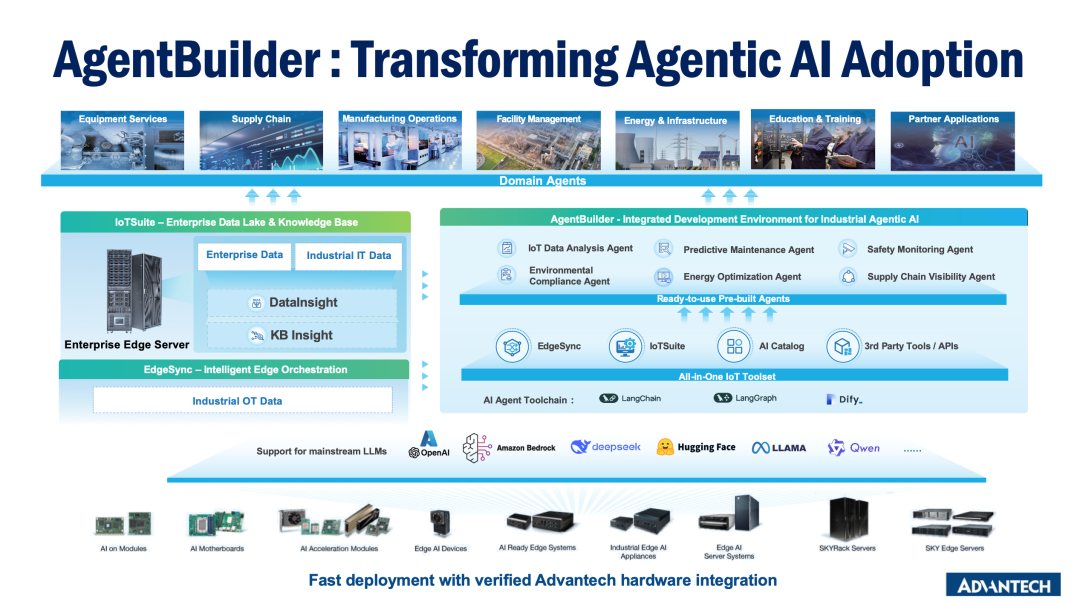
Fragmentation and low utilization of industrial data, stringent requirements for decision-making certainty and interpretability in industrial scenarios, and coordination among AI agents are challenges faced by industrial agents in their popularization. Advantech is deploying relevant technology stacks, providing products such as multi-modal data collection and communication connectivity products on the device side, an AI algorithm expert library for industrial scenarios, and the Agent Builder platform for data flow integration. The "breakthrough" between hardware and application software is of great significance for industrial transformation. These products centered around the core technology system of industrial agents provide a bridge for industrial customers to quickly introduce AI into industrial applications.
Of course, in addition to underlying hardware and software, to promote the development of industrial intelligence, the collaboration of the entire upstream and downstream ecosystem and industrial co-creation are also indispensable. During the in-depth exchange with Liu Kezhen, Chairman of Advantech, a core judgment gradually became clear: Industrial agents are not a technological innovation but a systemic transformation. The core of this transformation does not lie in "whether AI is strong enough" but in whether enterprises are ready to embrace a new industrial future dominated by "intelligent collaboration".
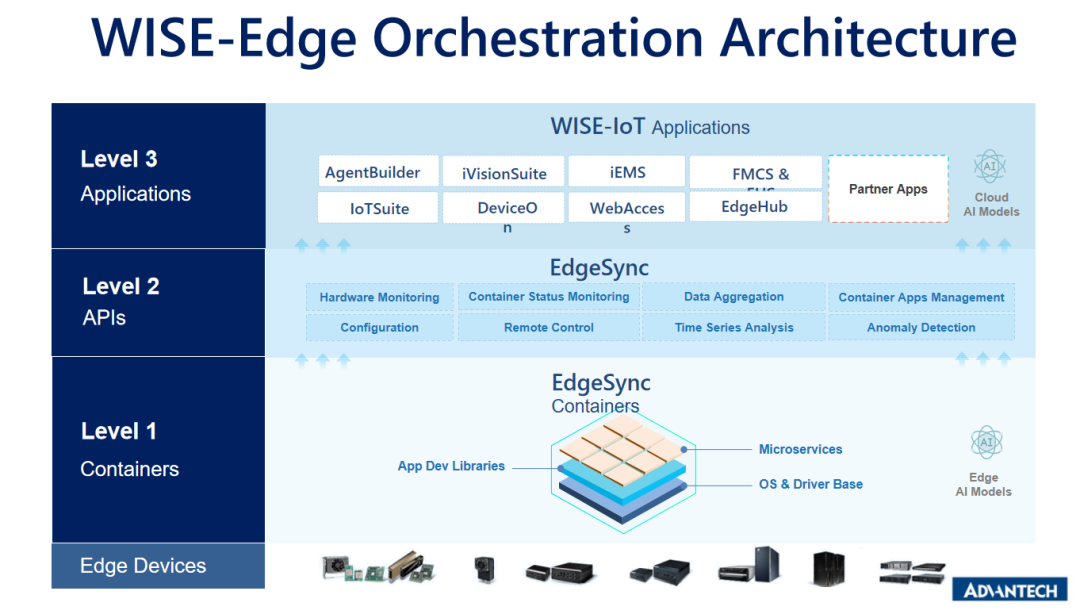
Liu Kezhen, Chairman of Advantech, particularly emphasized during the exchange that Advantech is accelerating cooperation with upstream and downstream players in the industrial chain. Through the WISE-Edge strategy, which links hardware and software integration at the edge, Advantech is building an industrial agent ecosystem that brings together AI chip manufacturers, multi-modal sensor suppliers, AI software technology enterprises, industry system integrators, and channel distributors focused on edge intelligence, forming a joint force to construct a thriving industrial agent ecosystem covering "end-edge-cloud". Riding this trend, Advantech is transforming into the role of "AIoT ecosystem enabler":
- Collaborating with AI chip manufacturers to build an edge computing power ecosystem.
- Partnering with system integrators to create industry solutions.
- Connecting channels and customers to build an edge intelligence scenario library.
The goal of this strategic transformation is to build an industrial agent ecosystem covering "end-edge-cloud" and achieve a leap from "hardware and software supply" to "enabling platform".
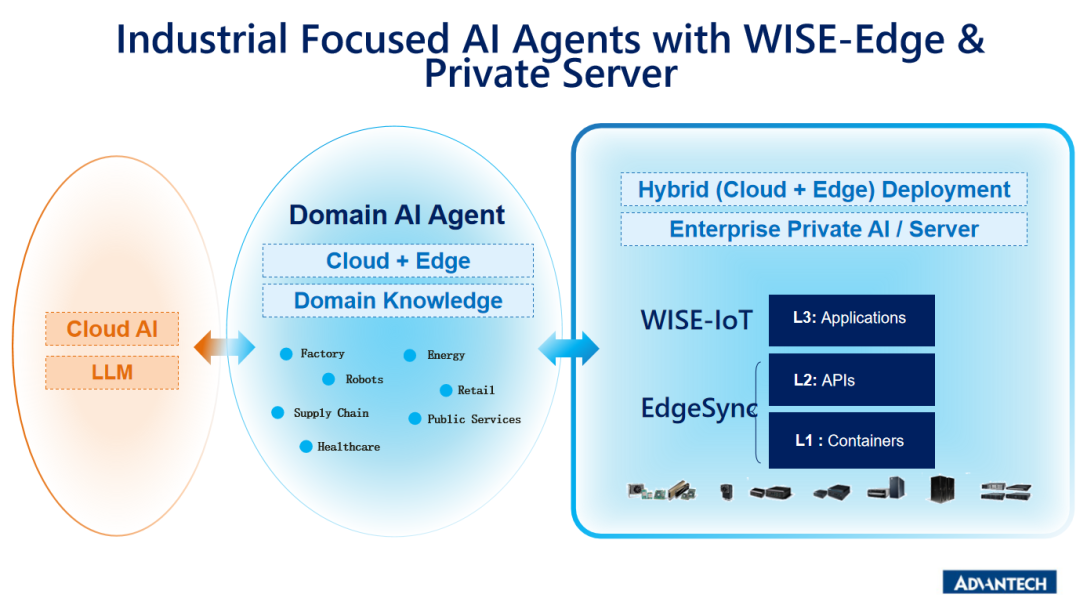
These profound strategic judgments not only point out a transformation path for Advantech itself, from "industrial computers to industrial agent platforms", but also provide a system-level architectural blueprint for the entire industrial AI ecosystem to refer to. The implementation of AI applications cannot rely on a single enterprise but should be a concerted effort of the entire upstream and downstream industrial chain to create a benign ecosystem for common development, so that the industry can move towards the general direction of edge AI and industrial intelligence.
The rise of vertical models is inevitable, heralding the eventual advent of the industrial agent era. IoT Intelligence and Advantech share an optimistic outlook on the emergence of edge intelligence and industrial agents, marking a significant transformation within the industry. While industrial AI models have yet to reach full maturity, and the realization of true industrial agents faces numerous hurdles, AI capabilities have become a pivotal competitive advantage in today's business landscape. The absence of AI capabilities will gradually lead to enterprises lagging behind in the wave of intelligence. As computational power at industrial edges continues to enhance, and models undergo qualitative shifts, the era of industrial agents draws nearer.
During a discussion, Advantech Chairman Liu Kezhen specifically highlighted "vertical AI models," noting that large language models and general models, while increasingly powerful and nearing market saturation, are transitioning towards open-source and free business models. The emergence of vertical models tailored to specific industries presents lucrative business opportunities. "Vertical models offer a robust mechanism for closed-loop business models, as niche industry models are rare and exclusive. In the future, these models may achieve breakthroughs in user engagement and revenue generation," Liu emphasized. He further believes that vertical models in focused fields should emerge first, driving the advancement of edge intelligence.
In my article, "Edge Intelligence + Vertical Models: The 'Dual Engines' of AIoT 2.0," I stated that "the rise of vertical models is inevitable." The scarcity of physical world data results in inherent limitations when applying general models in practical scenarios, preventing them from perfectly aligning with complex and diverse industry needs. To enable AI models to better comprehend industry-specific knowledge and address domain-specific challenges, customized vertical industry models represent the inevitable path for AI to evolve from "general intelligence" to "scenario intelligence."
For AIoT scenarios, edge intelligence and vertical models serve as dual engines, with edge intelligence providing the foundational infrastructure. As infrastructure transformation matures, specific vertical models develop across various industries, indicating that the maturity of vertical models lags behind that of edge intelligent hardware infrastructure. Despite the debate on which comes first, there is consensus on the inevitable rise of vertical models. Industrial agents, leveraging vertical model capabilities, will ultimately catalyze a profound intelligence transformation within industrial scenarios.
Concluding Thoughts: From large models to small models, and ultimately to vertical models, coupled with the transition from edge computing to edge intelligence, it will take time for the industry to reach a consensus on these cutting-edge developments and patiently await their maturation. The birth of industrial agents not only extends industrial automation but also redefines the manufacturing operating system, propelling the industry from "tool intelligence" to "system intelligence" and from "data-driven" to "knowledge autonomy." With technological advancements and expanding applications, industrial agents, integrating edge intelligence and vertical models, will unleash unprecedented potential, significantly enhancing productivity and resource allocation efficiency. They will fundamentally reshape production models, driving the intelligent industry towards high-quality development.






